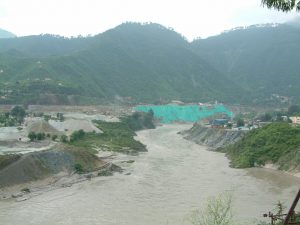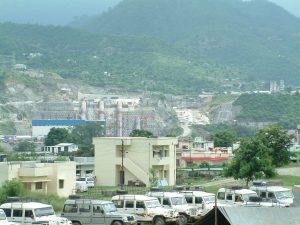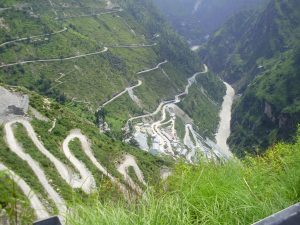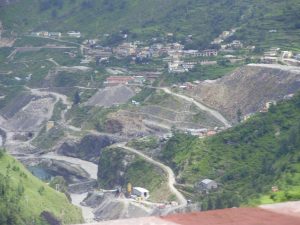Memo#120
(The final Memo from the Theme, Water, Scarcity, and Tibetan Plateau Frontiers)
By Kelly Alley – alleykd [at] auburn.edu
 The vital rivers of the state of Uttarakhand in northwestern India may soon disappear. A multitude of feeder streams and tributaries that run through the state carve tight passages through steep mountains before joining the sacred river Ganga (Ganges). Ancient and contemporary Hindu traditions are steeped in worship of these tributary rivers, and their sacred confluences are named “prayags”. But Uttarakhand is part of a frantic push across India, Pakistan, Nepal, Bhutan, and China to harness the rivers of the Himalayas for hydroelectric power. This movement threatens to alter entire river systems in an unprecedented way.
The vital rivers of the state of Uttarakhand in northwestern India may soon disappear. A multitude of feeder streams and tributaries that run through the state carve tight passages through steep mountains before joining the sacred river Ganga (Ganges). Ancient and contemporary Hindu traditions are steeped in worship of these tributary rivers, and their sacred confluences are named “prayags”. But Uttarakhand is part of a frantic push across India, Pakistan, Nepal, Bhutan, and China to harness the rivers of the Himalayas for hydroelectric power. This movement threatens to alter entire river systems in an unprecedented way.
In Uttarakhand, 13 dams of various sizes have been constructed on the main tributaries and feeder streams of the Bhagirathi and Alaknanda Rivers; and 57 more are in progress. 16 of these projects will use large reservoirs to capture and store water behind barrages. The other 54 will divert water from the river stream, run it through blasted mountain rock, and race it down a steep shaft to rotate turbines. The water will be returned to the main riverbed in a great flush and then quickly pushed behind another barrage and fed into another set of mountain tunnels. When complete, this engineering marvel will subject 40 per cent of each main tributary to diversion and submergence.
In 2009, the High Court of Uttarakhand asked for a comprehensive study of the foreseeable cumulative impacts of these dam projects on human communities, river systems, and local and regional ecosystems. In June 2011, the Ministry of Environment and Forests released the Study on Assessment of Cumulative Impact of the Hydropower Projects in Alaknanda and Bhagirathi Basins up to Devprayag.
Tragically, the final report endorses every single proposed project in Uttarakhand, with suggestions for mitigation, thereby concluding that cumulative impacts will not push river systems or ecological and human support systems into the danger zone. The report also calls for resurrecting three dam projects cancelled on the upper Bhagirathi River last year.
About the Author:
Kelly Alley -Professor of Anthropology at Auburn University and author of, On the Banks of the Ganga: When Wastewater Meets a Sacred River (2002).
The study promises a future of disappearing rivers – the roar of rivers muted by stone tunnels and sacred prayags dried to sediment.
- Mountains of Concrete: Dam Building in the Himalayas, International Rivers, 2008.
- Damning Audit, Frontline, 2010.
- Fate of Alaknanda Worse than that of Bhagirathi, South Asian Network for Dams, Rivers and People, 2008.
- Study on Assessment of Cumulative Impact of Hydropower Projects in Alaknanda and Bhagirathi Basins up to Devprayag, Alternate Hydro Energy Center, Indian Institute of Technology, 2011.
- Comments on the AHEC/2011 Report, South Asian Network for Dams, Rivers and People, 2011.
Related Memos:
- Cooperative Management of Mekong River is Crucial for 70 Million People (Memo #32, by Richard Paisley)
- Interview with Dai Qing, the Environmental Activist, Investigative Journalist, and Writer (Memo #39, Video Interview)



